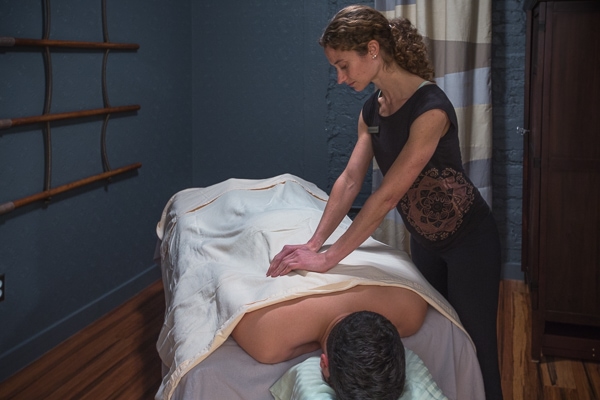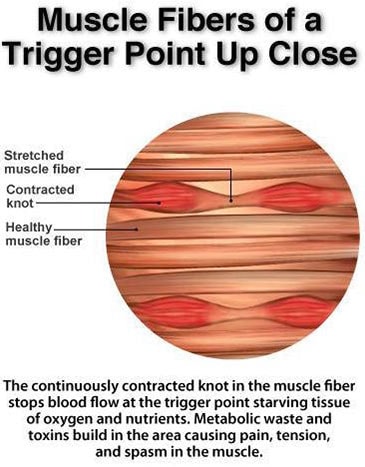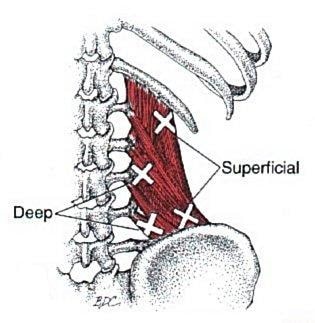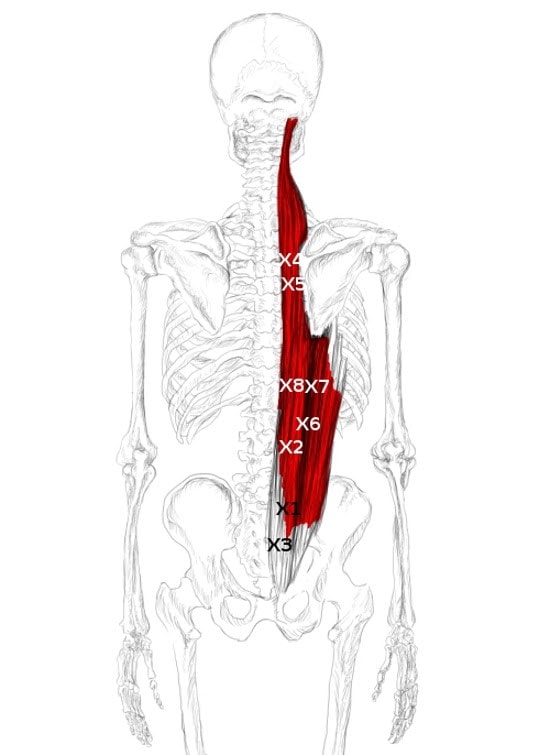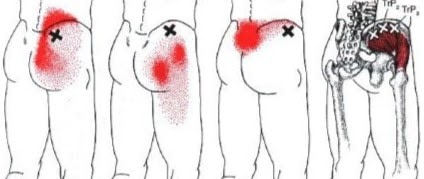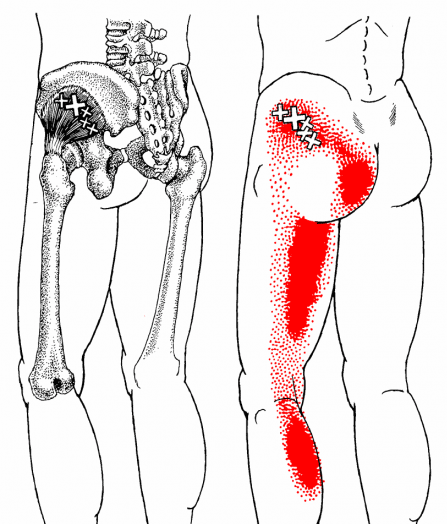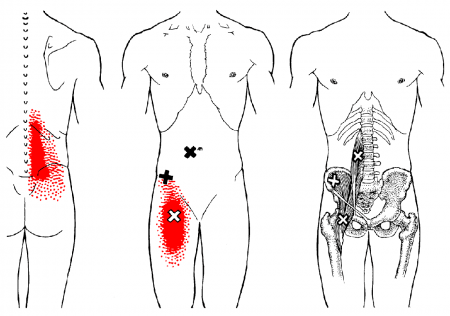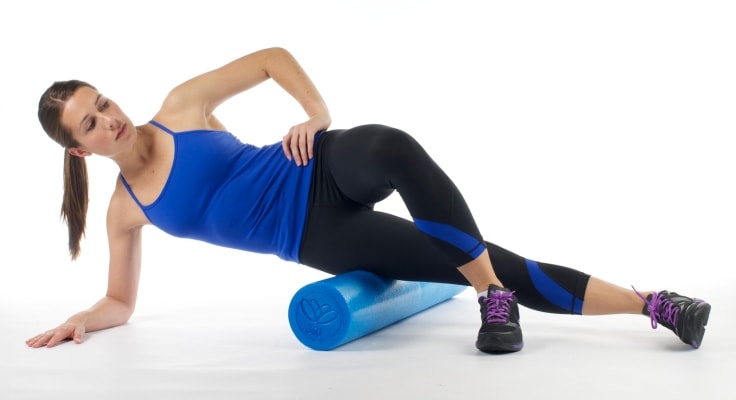Licensed Massage Therapist, Amy Montia, takes a closer look at the causes of back pain, and some of the most common trigger points that can develop from poor posture or injury.
Benefits of Massage Therapy for Low Back Pain
If our low back aches, the rest of our body– mind and spirit too– will start to feel the same way. Pain, fear, hesitance and negative emotions associated with low back pain can keep discomfort in your back and potentially turn minor discomfort into a major problem.
Massage therapy is a great way to help relieve minor low back discomfort and it can prevent a larger problem from setting in.
One of the keys to good posture is having good muscle balance and tension around our spine, particularly in our lower back. Sitting, standing, commuting, carrying things, exercising, sleeping- our normal activities of daily living challenge our postural alignment constantly.
As muscles chronically work to keep us stable and balanced, some muscle strands get tangled and form palpable knots. These knots intertwine with fascia, neurons and pain receptors, and even adhere to adjacent muscles. They may render muscles weak muscles or short, which consequently makes other muscles overwork or inhibited.
Back pain massage can intervene into this process and help restore balance, by releasing tension and knots (also called trigger points) in overworked muscles, and encouraging underworked muscles to work more efficiently. Massage therapy also minimizes perceived pain and tightness, brings relaxation and restores better breathing patterns.
What are Trigger Points?
Trigger points, first described by Janet Travell and David Simons, are small palpable hyper-irritable muscle knots. Trigger points cause pain and perceived “tightness” locally around the actual trigger point, and may refer pain in a predictable pattern to areas distant from the actual knot.
Lack of oxygen and proper circulation around a trigger point (called ischemia) allows build-up of metabolic and inflammatory byproducts around the knot and causes adhesion to neighboring muscles and structures.
Massage therapy on trigger points and related adhesion can provide significant and sometimes immediate relief. Self-massage into these points helps to keep discomfort minimal.
Trigger point therapy can be incorporated into any massage session. A trained Massage Therapist can effectively identify trigger points through palpation of muscle tissue combined with client report of symptoms and pain patterns.
Following general work to warm up the area, trigger points can be released in several ways. The technique used depends mostly on the client’s goals for the session and also pain tolerance level. Trigger points can be released using a combination of ischemic compression, deep petrissage, “stretch and release” techniques, and even Manual Lymphatic drainage (MLD).
Refer to the Physio Logic website for more info on these techniques. Most therapists will cue you on when and how to inhale and exhale to help control the discomfort and make the release more effective as well as lower back stretches to help you release your spine.
Common Trigger Point Patterns
Below I describe in more detail some common trigger point patterns in four muscles that are almost always associated with low back pain:
Quadratus Lumborum
The Quadratus Lumborum (QL) is a deep close to the spine low back muscle located close to the spine that runs between the bottom rib and the iliac crest.
It’s important for postural and lateral stability, especially when standing on one leg. QL assists with lateral spine flexion (bending side to side) and hiking the hip.
Trigger points develop throughout the muscle belly, especially if core, superficial back muscles and/or gluts are weak.
The trigger points labeled “deep” are adjacent to the psoas muscle (see below for more about psoas). QL and psoas sometimes adhere in this area. Active Release Technique (ART) is helpful to release these adhesions between QL and psoas.
Trigger points at the bottom edge, near where the hip bone meets the low back, snowball with gluteus medius, gluteus maximus, thoracolumbar fascia and sacroiliac (SI) fascia to form palpable adhesions along the iliac crest.
QL trigger points refer pain into the low back, posterior hip and sometimes the front of the thigh. Using a Tennis ball or Spalding ball to dig into these areas is a useful way to relieve occasional discomfort.
QL trigger points sometimes facilitate gluteus medius muscle hypertonicity, so by releasing QL, you’re also helping gluteus medius function (see below for more about gluteus medius).
Erector Spinae
(Iliocostalis thoracis, Iliocostalis lumborum and iliocostalis lumborum)
Erector Spinae describes not one muscle, but actually a bundled muscle group comprised of spinalis, longissimus, and iliocostalis, that runs parallel to the spine from head to the sacrum.
These are bulky superficial muscles. You can feel them on either side of your spine.
The primary function of this collective muscle group is to extend the spine (aka bend backwards, reach up to the sky). Trigger points commonly form in the iliocostalis portions of this muscle group around the T5-T11, the mid-thoracic vertebrae. These muscles often become exhausted and overworked, and develop trigger points when deep low back muscles are underutilized and when core muscles are not well conditioned.
Trigger pointss in the thoracic area refer pain locally and also into the low back.
Lying on a foam roller (both perpendicular and parallel to the spine) and rolling slowly to “iron” out your back is a nice way to gently release these knots and restore circulation in tight areas.
Gluteus Medius and Gluteus Minimus
Gluteus Medius is a hip muscle that lies under the gluteus maximus muscle and is important in hip stability and abduction (aka lifting your leg out to the side). Glut medius works closely with QL and the internal obliques to provide lateral sling function, keeping core and hips in communication when standing, walking, running, moving, etc.
Glut medius trigger points tend to form closer to the top edge, near the iliac crest, and they may refer pain into the low back and into the hip. These are infamous for the intense discomfort felt when worked on. But trigger point release work on glut medius paired with simple corrective exercise is effective for reducing chronic low back pain.
Glut minimus lies deep to gluteus medius. Trigger points in glut min may refer pain down the side and back of the thigh. The referral pattern is similar to and sometimes mistaken as “sciatic” pain. (True sciatic pain occurs when the sciatic nerve is pinched by lumbar vertebrae at the nerve root, or trapped under or inbetween tight deep hip rotator muscles.)
Rolling on your side or on your back with a small foam roller perpendicular to your body is a good way to self-treat the glut med/min muscles. The movement should be small slow back and forth motions both along and across on the muscle.
Iliopsoas
Iliopsoas muscle is actually 2 muscles, iliacus and psoas, that merge and share a common attachment site at the femur head (thigh bone). Psoas is a thick circular muscle that runs along the front of the spine, attaching along lumbar vertebrae 1-5 and inserting into the top of the femur.
It is a hip flexor. But when the feet are planted, it becomes a lumbar spine flexor (bends the lumbar spine forward). If the psoas muscle is short, it contributes to an increased lordotic curve (dramatic arch angle) in the lumbar spine, which can contribute to low back pain and trigger point formation.
Psoas trigger points refer pain predictably into the entire low back and sometimes into the front of the thigh.
Iliacus runs along inside surface of the iliac bone to attach with psoas at the femur head. Improper or prolonged sitting contributes to a weakened psoas and iliacus trigger points. Iliiacus tightness can inhibit psoas function.
Releasing these points is very helpful. You can probably feel your own tight iliacus muscles. Sit on the edge of a chair, feet planted. With your thumbs, trace along your hip bones from the front to back. As you trace around toward your low back, sink your thumbs down into the inside surface of your hip bones. That is the iliacus and perhaps internal oblique fascia adhering to it.
Active Release Technique (ART) combined with trigger point release to iliacus/psoas works well to release and eccentrically lengthen the psoas, which will minimize low back discomfort.
Breathing Patterns and Trigger Point Release
When you foam roll or self massage to release trigger points, try to keep track of your breathing pattern:
- Take slow deep inhale-exhales
- Inhale through your nose like you are smelling roses.
- Exhale through your mouth like you are blowing through a straw.
- Make your exhale last a few seconds longer than your inhale.
- Gently pull your bellybutton in toward your spine as you exhale.
